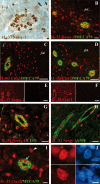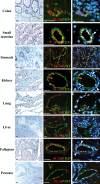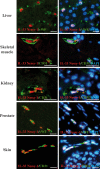The IL-1-like cytokine IL-33 is constitutively expressed in the nucleus of endothelial cells and epithelial cells in vivo: a novel 'alarmin'?
- PMID: 18836528
- PMCID: PMC2556082
- DOI: 10.1371/journal.pone.0003331
The IL-1-like cytokine IL-33 is constitutively expressed in the nucleus of endothelial cells and epithelial cells in vivo: a novel 'alarmin'?
Abstract
Background: Interleukin-33 (IL-33) is an IL-1-like cytokine ligand for the IL-1 receptor-related protein ST2, that activates mast cells and Th2 lymphocytes, and induces production of Th2-associated cytokines in vivo. We initially discovered IL-33 as a nuclear factor (NF-HEV) abundantly expressed in high endothelial venules from lymphoid organs, that associates with chromatin and exhibits transcriptional regulatory properties. This suggested that, similarly to IL-1alpha and chromatin-associated cytokine HMGB1, IL-33 may act as both a cytokine and a nuclear factor. Although the activity of recombinant IL-33 has been well characterized, little is known yet about the expression pattern of endogenous IL-33 in vivo.
Methodology/principal findings: Here, we show that IL-33 is constitutively and abundantly expressed in normal human tissues. Using a combination of human tissue microarrays and IL-33 monoclonal and polyclonal antibodies, we found that IL-33 is a novel nuclear marker of the endothelium widely expressed along the vascular tree. We observed abundant nuclear expression of IL-33 in endothelial cells from both large and small blood vessels in most normal human tissues, as well as in human tumors. In addition to endothelium, we also found constitutive nuclear expression of IL-33 in fibroblastic reticular cells of lymphoid tissues, and epithelial cells of tissues exposed to the environment, including skin keratinocytes and epithelial cells of the stomach, tonsillar crypts and salivary glands.
Conclusions/significance: Together, our results indicate that, unlike inducible cytokines, IL-33 is constitutively expressed in normal human tissues. In addition, they reveal that endothelial cells and epithelial cells constitute major sources of IL-33 in vivo. Based on these findings, we speculate that IL-33 may function, similarly to the prototype 'alarmin' HMGB1, as an endogenous 'danger' signal to alert the immune system after endothelial or epithelial cell damage during trauma or infection.
Conflict of interest statement
Figures






References
-
- Schmitz J, Owyang A, Oldham E, Song Y, Murphy E, et al. IL-33, an interleukin-1-like cytokine that signals via the IL-1 receptor-related protein ST2 and induces T helper type 2-associated cytokines. Immunity. 2005;23:479–490. - PubMed
-
- Allakhverdi Z, Smith DE, Comeau MR, Delespesse G. Cutting edge: The ST2 ligand IL-33 potently activates and drives maturation of human mast cells. J Immunol. 2007;179:2051–2054. - PubMed
Publication types
MeSH terms
Substances
LinkOut - more resources
Full Text Sources
Other Literature Sources
Molecular Biology Databases

